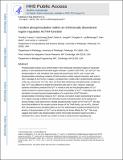| dc.contributor.author | Travers, Timothy | |
| dc.contributor.author | Shao, Hanshuang | |
| dc.contributor.author | Wells, Alan | |
| dc.contributor.author | Camacho, Carlos J. | |
| dc.contributor.author | Joughin, Brian Alan | |
| dc.contributor.author | Lauffenburger, Douglas A | |
| dc.date.accessioned | 2015-10-29T14:07:26Z | |
| dc.date.available | 2015-10-29T14:07:26Z | |
| dc.date.issued | 2015-05 | |
| dc.date.submitted | 2014-10 | |
| dc.identifier.issn | 1945-0877 | |
| dc.identifier.issn | 1937-9145 | |
| dc.identifier.uri | http://hdl.handle.net/1721.1/99497 | |
| dc.description.abstract | Phosphorylated residues occur preferentially in the intrinsically disordered regions of eukaryotic proteins. In the disordered amino-terminal region of human a-actinin-4 (ACTN4), Tyr[superscript 4] and Tyr[superscript 31] are phosphorylated in cells stimulated with epidermal growth factor (EGF), and a mutant with phosphorylation-mimicking mutations of both tyrosines exhibits reduced interaction with actin in vitro. Cleavage of ACTN4 by m-calpain, a protease that in motile cells is predominantly activated at the rear, removes the Tyr[superscript 4] site. We found that introducing a phosphomimetic mutation at only Tyr[superscript 31] was sufficient to inhibit the interaction with actin in vitro. However, molecular dynamics simulations predicted that Tyr[superscript 31] is mostly buried and that phosphorylation of Tyr[superscript 4] would increase the solvent exposure and thus kinase accessibility of Tyr[superscript 31]. In fibroblast cells, EGF stimulation increased tyrosine phosphorylation of a mutant form of ACTN4 with a phosphorylation-mimicking residue at Tyr[superscript 4], whereas a truncated mutant representing the product of m-calpain cleavage exhibited EGF-stimulated tyrosine phosphorylation at a background amount similar to that observed for a double phosphomimetic mutant of Tyr[superscript 4] and Tyr[superscript 31]. We also found that inhibition of the receptor tyrosine kinases of the TAM family, such as AXL, blocked EGF-stimulated tyrosine phosphorylation of ACTN4. Mathematical modeling predicted that the kinetics of phosphorylation at Tyr[superscript 31] can be dictated by the kinase affinity for Tyr[superscript 4]. This study suggests that tandem-site phosphorylation within intrinsically disordered regions provides a mechanism for a site to function as a switch to reveal a nearby function-regulating site. | en_US |
| dc.description.sponsorship | National Institutes of Health (U.S.) (Grant R01 GM69668) | en_US |
| dc.language.iso | en_US | |
| dc.publisher | American Association for the Advancement of Science (AAAS) | en_US |
| dc.relation.isversionof | http://dx.doi.org/10.1126/scisignal.aaa1977 | en_US |
| dc.rights | Creative Commons Attribution-Noncommercial-Share Alike | en_US |
| dc.rights.uri | http://creativecommons.org/licenses/by-nc-sa/4.0/ | en_US |
| dc.source | PMC | en_US |
| dc.title | Tandem phosphorylation within an intrinsically disordered region regulates ACTN4 function | en_US |
| dc.type | Article | en_US |
| dc.identifier.citation | Travers, T., H. Shao, B. A. Joughin, D. A. Lauffenburger, A. Wells, and C. J. Camacho. “Tandem Phosphorylation Within an Intrinsically Disordered Region Regulates ACTN4 Function.” Science Signaling 8, no. 378 (May 26, 2015): ra51–ra51. | en_US |
| dc.contributor.department | Massachusetts Institute of Technology. Department of Biological Engineering | en_US |
| dc.contributor.department | Koch Institute for Integrative Cancer Research at MIT | en_US |
| dc.contributor.mitauthor | Joughin, Brian A. | en_US |
| dc.contributor.mitauthor | Lauffenburger, Douglas A. | en_US |
| dc.relation.journal | Science Signaling | en_US |
| dc.eprint.version | Author's final manuscript | en_US |
| dc.type.uri | http://purl.org/eprint/type/JournalArticle | en_US |
| eprint.status | http://purl.org/eprint/status/PeerReviewed | en_US |
| dspace.orderedauthors | Travers, T.; Shao, H.; Joughin, B. A.; Lauffenburger, D. A.; Wells, A.; Camacho, C. J. | en_US |
| mit.license | OPEN_ACCESS_POLICY | en_US |
| mit.metadata.status | Complete | |
